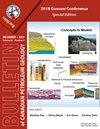The shallow stratigraphy and geohazards of the Northeast Baffin Shelf and Lancaster Sound
Q3 Earth and Planetary Sciences
引用次数: 20
Abstract
Abstract Hydrocarbon resource potential and a growing population have increased the need for new marine infrastructure in the Baffin Bay region. Before determining the viability of any seabed development, scientific understanding of geological hazards is essential. For this study, high resolution geophysical data and sediment samples on the Northeast Baffin Shelf and Lancaster Sound were analyzed to develop a shallow geological framework for the area and determine the distribution and severity of seabed hazards. The modern seafloor morphology and shallow stratigraphy are strongly influenced by past glacial processes. The Northeast Baffin Shelf consists of glacially eroded transverse troughs separated by flat-topped banks where glacial ice-contact and ice-proximal sediments rest on bedrock and are overlain discontinuously by postglacial sand or mud of various thickness. Lancaster Sound, which was occupied by glacial ice during the last glaciation, shares a similar shallow stratigraphy. Geohazards in the Baffin region differ from elsewhere on Canada's eastern continental margin. It is a seismically-active passive margin and its Arctic location means the area is more prone to the effects of iceberg scour and sea ice. Geohazards on the Baffin Shelf include hydrocarbon venting features, uneven seabed caused by glacial seabed features, seabed instability and sediment transport at trough margins, ice scour, and a high level of seismic activity.东北巴芬陆架和兰开斯特海峡浅层地层与地质灾害
油气资源潜力和不断增长的人口增加了巴芬湾地区对新的海洋基础设施的需求。在确定任何海底开发的可行性之前,对地质灾害的科学了解是必不可少的。本研究通过分析巴芬东北陆架和兰开斯特海峡的高分辨率地球物理数据和沉积物样本,建立了该地区的浅层地质框架,并确定了海底灾害的分布和严重程度。现代海底形态和浅层地层学受过去冰川作用的强烈影响。东北巴芬陆架由被冰川侵蚀的横向沟槽组成,沟槽被平顶河岸隔开,其中冰川冰接触和冰近沉积物位于基岩上,并被不同厚度的冰后砂或泥不连续地覆盖。兰开斯特海峡在末次冰期被冰川覆盖,有着相似的浅层地层。巴芬地区的地质灾害不同于加拿大东部大陆边缘的其他地区。这是一个地震活跃的被动边缘,它的北极位置意味着该地区更容易受到冰山冲刷和海冰的影响。巴芬大陆架上的地质灾害包括烃类喷吐特征、冰川海底特征造成的海底不均匀、海底不稳定和槽缘沉积物运输、冰冲刷以及高水平的地震活动。
本文章由计算机程序翻译,如有差异,请以英文原文为准。
求助全文
约1分钟内获得全文
求助全文
来源期刊

Bullentin of Canadian Petroleum Geology
Earth and Planetary Sciences-Geochemistry and Petrology
CiteScore
2.50
自引率
0.00%
发文量
0
期刊介绍:
The Bulletin of Canadian Petroleum Geology is a peer-reviewed scientific journal published four times a year. Founded in 1953, the BCPG aims to be the journal of record for papers dealing with all aspects of petroleum geology, broadly conceived, with a particularly (though not exclusively) Canadian focus. International submissions are encouraged, especially where a connection can be made to Canadian examples.
 求助内容:
求助内容: 应助结果提醒方式:
应助结果提醒方式:


